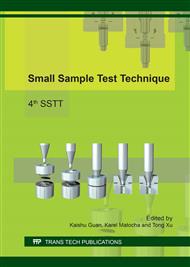p.202
p.206
p.212
p.237
p.251
p.260
p.273
p.285
p.293
Evaluation of Creep Deformation by Indentation Test with a Constant Depth - Applicability for Inhomogeneous Materials
Abstract:
In design of the electronic device, FEM analyses considering the creep deformation of solder joints in-situ should be conducted to evaluate the strength reliability. The indentation test is one of effective method to evaluate the creep deformation in microscopic region. However, the result obtained by the indentation test does not coincide with that obtained by the tensile creep test. To solve the problem, the method to determine the suitable area for the indentation test had also been proposed by using the numerical test. To apply the proposed method for the actual indentation test, the homogeneity of specimen should be considered. In this paper, the analyses of the proposed indentation tests were conducted by using the homogeneous and inhomogeneous specimen models of Sn-3.0Ag-0.5Cu. Three types of the deformation behavior were given for the initial phase and the indenter was pushed into in the specimen at the three locations. As a result, it was found that there was not difference in the distribution of the principal stress caused by variation in the indent location. However, the proposed method can successfully determine the reference area except for the case when the deformation behaviors of the constituent phases have a large difference.
Info:
Periodical:
Pages:
251-259
Citation:
Online since:
April 2017
Authors:
Keywords:
Price:
Сopyright:
© 2017 Trans Tech Publications Ltd. All Rights Reserved
Share:
Citation:


